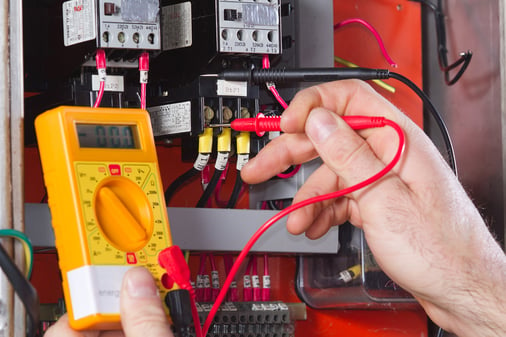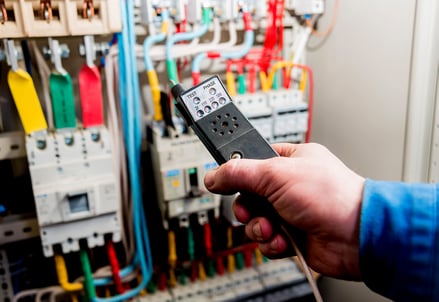If you are responsible for managing your plant’s electrical power system and maintenance plan, there are four predictive maintenance tests that should be incorporated into an overall maintenance program. These tests can reduce the need for offline services, improve system performance, reduce the risk of system failure and help optimize budgeted expenditures.
These predictive maintenance tests can be performed while system are online. They are non-destructive, non-invasive and examine electrical equipment under normal operating conditions. Ideally, you should coordinate these tests between planned outages so the resulting data can be used to inform and help prioritize offline service needs.
Predictive maintenance procedures
Four online predictive maintenance procedures for evaluating electrical system health are:
-Visual inspection
-Partial discharge testing
-Infrared/thermographic survey
-Insulating fluid sampling and analysis In combination, these four activities can identify variations in properties that indicate impending asset failure. If performed by a qualified testing agency, they can be executed efficiently and cost effectively and provide significant benefits including:
In combination, these four activities can identify variations in properties that indicate impending asset failure. If performed by a qualified testing agency, they can be executed efficiently and cost effectively and provide significant benefits including:
-Equipment can be evaluated under normal operating conditions
-Collection of trending data for predictive assessments
-Identify issues before significant problems occur
-Identify equipment to be prioritized during maintenance outage.
-Provide data that allows for extending time between scheduled outages
-Improve budget allocation toward most critical maintenance needs.
Additionally, predictive maintenance services can be performed more frequently than offline services and thereby reduce the risk of incidents and system related outages, improving employee and public safety, increasing peace of mind and preventing problems that could affect your plant’s reputation and operational credibility.
Online predictive maintenance
Online predictive maintenance uses multiple types of technology depending on the equipment. An experienced field engineer or technician will know which technology to use and how to apply it when evaluating each asset. Each technology provides a unique set of data that, when used in combination, provides a good understanding of the health of your overall system.
Visual inspections: Visual Inspection is the examination of equipment without needing to open enclosures. A qualified technician is trained to recognize abnormal conditions indicating increased risk factors to safety or equipment reliability.
A standard visual inspection check list includes:
-Cleanliness
-Condition of paint

-Equipment area clearances
-Condition of grounds
-Cracked or contaminated insulators and bushings
-Fluid levels/leaks
-Fluid/winding temperature gauges
-Gas pressure
-Relay status and targets.
Partial discharge (PD) testing: Partial discharge testing uses sensors to detect voltage stresses imposed by the system voltage on deteriorated insulation components. Deteriorated insulation generates signals with partial discharge characteristics. The PD sensors detect these small electrical signals or discharges that occur within or on the surface of the insulation of medium and high voltage electrical assets. Protracted partial discharge can erode solid insulation and eventually lead to breakdown and failure.
PD surveys can be performed on gaseous, liquid or solid insulating media. Survey results can be used to set priorities and manage maintenance schedules.
Partial discharge surveys report on the magnitude, location and type of insulation degradation.
PD test results identify assets needing additional attention and/or offline maintenance.
Trending partial discharge data over time can assist asset managers with strategic decisions regarding the repair or replacement of assets.
There are many types of PD sensor technologies and the accuracy of PD detection can be improved through use of multiple PD detection and sensor types. These technologies include various types of acoustic and electromagnetic sensors.
Ultrasonic microphones and directional UHF sensors: Ultrasonic microphones and directional UHF sensors can be used to assess the health of equipment housed in indoor metal enclosures such as medium voltage switchgear. The sensors will display signals of interest during the testing process that an experienced field engineer can recognize and use to identify the likely cause and location of the PD source so that issues can be addressed as needed.
Ultrasonic dish sensors: Ultrasonic dish sensors scan for PD signals from various substation equipment such as bushings, insulators, switches, PTs and terminations.
Acoustic contact sensors: Acoustic contact sensors can be used to detect PD within gas and liquid filled equipment.
Transient earth voltage (TEV) sensors: Transient earth voltage (TEV) sensors measure voltages induced on metal enclosures as a result of electromagnetic signals generated by PD.
Wireless HFCT transmitter: The wireless high frequency current transformer (HFCT) transmitter connects to a permanent or temporarily mounted terminal box and monitors a cable circuit. The sensors detect PD from the cable providing an early warning of cable deterioration. This sensor also can be used to detect signals on equipment grounding conductors.
Infrared testing: A thermographic survey is performed using an infrared scanner (camera) to identify conditions that could result in a fire or electrical failure. It can detect connections with elevated resistance (loose, dirty, corroded, etc.) caused by deterioration of electrical connections due to vibration, improper torque or corrosion. Elevated resistance generates abnormal heating that can be detected during a thermographic inspection. The survey also provides an opportunity for internal visual inspections of switchgear. Infrared reports provide high-resolution, color-digitized photographs and thermograms showing “hot spots,” a description of deficiency and recommendations for correction or repair.
Insulating fluid sampling and analysis: One of the most effective ways to determine the condition of a liquid-filled transformer is to obtain a fluid sample and perform a laboratory analysis.
 Insulating fluid sampling allows the analysis of chemical properties, dissolved gases and identification of contaminants and debris, which offers clues to equipment condition and indicators of insulation breakdown or failing connections. These fluids provide a cooling medium to transfer heat from the coils to the radiators and into the air. They insulate the windings and reduce high voltage stresses. Over time, the fluids become contaminated due to heat, insulation deterioration, moisture, air (oxidation) and corrosion. An insulating fluid analysis report includes dielectric breakdown, moisture content, color, acidity, interfacial tension, specific gravity and fluid power factor.
Insulating fluid sampling allows the analysis of chemical properties, dissolved gases and identification of contaminants and debris, which offers clues to equipment condition and indicators of insulation breakdown or failing connections. These fluids provide a cooling medium to transfer heat from the coils to the radiators and into the air. They insulate the windings and reduce high voltage stresses. Over time, the fluids become contaminated due to heat, insulation deterioration, moisture, air (oxidation) and corrosion. An insulating fluid analysis report includes dielectric breakdown, moisture content, color, acidity, interfacial tension, specific gravity and fluid power factor.
Most failures of electrical equipment are the result of poor connections or failed insulation. By combining infrared scanning, which identifies poor connections and other overheating conditions with partial discharge that detects deteriorated insulation, you are minimizing the risk of in-service failures. Couple these benefits with transformer fluid analysis (one of your most expensive electrical assets) and the trained eyes of an experienced field engineer, and you will see a significant reduction in equipment failures and service interruptions.
Online testing and maintenance reporting
Following the execution of the online testing and maintenance services, a standardized report is generated with recommended follow-up actions. A quality report should:
-Recommend corrective actions with priority
-Identify findings that require immediate investigation/repairs
-Identify findings that require additional trending/monitoring
-Identify findings that require additional diagnostics.
Final thoughts
Historically, many managers have used one or more conventional maintenance strategies including time-based maintenance and reliability-centered maintenance. Some simply opt for a run-to-failure approach. In today’s business environment of 24/7/365 operations, maintenance strategies are changing. This is causing a trend toward an “as-required” maintenance strategy made possible through advances in online testing and maintenance technologies. An “as-required” maintenance strategy performs maintenance based on indicators such as results from online surveys, operating environment, age and history of asset, service (loading) and criticality of equipment served. This is like a reliability-based maintenance strategy but includes consideration of online survey data.
The online testing and maintenance services described in this article are meant to compliment required offline testing and maintenance and should be part of a facility’s integrated life cycle management plan. While there are upfront costs associated with online testing and maintenance, the expense is often easily offset by cost savings from optimized offline testing and maintenance, as well as a reduction in emergency services. Most importantly, these services deliver the vital information a facility manager needs to prioritize assets needing attention and avoid wasting resources on equipment that remain in good, reliable condition. Decisions to extend outage schedules can be made without increasing risk of in-service failures, and budgets can be optimized. The data can also be of value in planning for asset replacements or future system upgrades.
To learn more about Radwell International
For a behind the scenes look at Radwell International
View the original article and related content on Plant Engineering
https://www.plantengineering.com/articles/how-to-improve-electrical-maintenance-with-predictive-tests/


